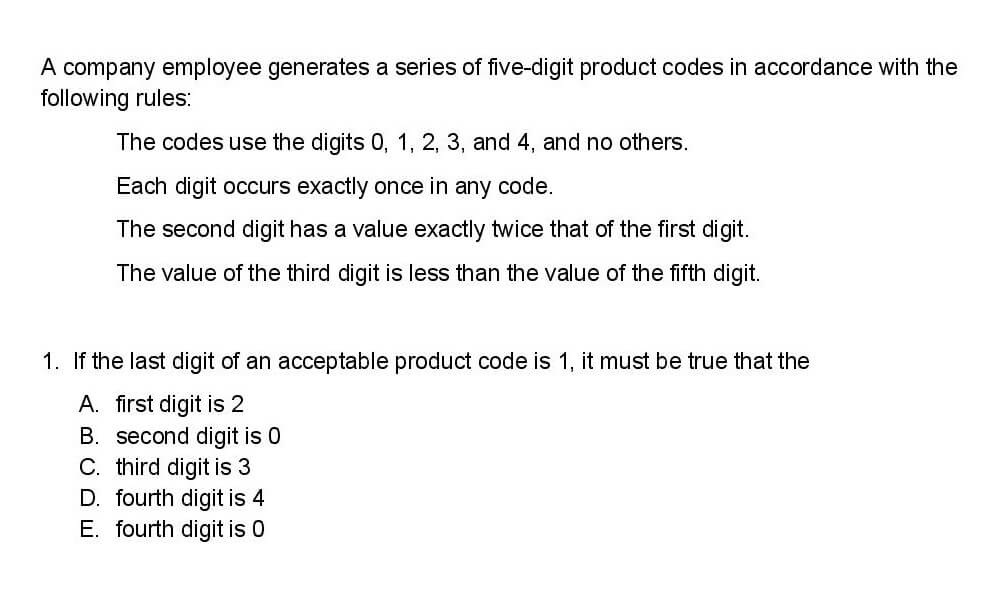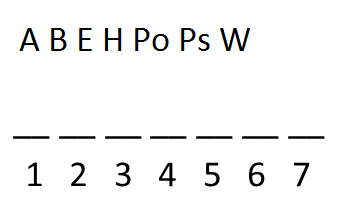The Analytical Reasoning section, also known as Logic Games, is a unique section on the LSAT. Keep reading to get the Logic Games basics, including what to expect and strategies to approach this section.
What is the LSAT Logic Games section?
As far as LSAT Logic Games basics go, you should know this: This LSAT section contains four “games,” each with three main components: a central setup describing some task that must be completed, a set of rules to follow when completing that task, and 5-7 accompanying questions. The setup, rules, and questions vary in complexity and difficulty, but there are typically one or two easier games and one or two harder games on each exam. Below is an example of a game setup and a question, borrowed from LSAC’s free, official online practice test.

There are 23 questions in an LSAT Logic Games section, and there is only one scored Logic Games section per test. Therefore, Logic Games will account for about 23% of your total LSAT score. Here are some tips to help you cope with the LSAT Logic Games section.
Set a goal for your LSAT Logic Games score
Read Setting LSAT Prep Goals for a detailed explanation of how to set reasonable goals for your LSAT prep. In short, an excellent goal for the LSAT Logic Games section is to decrease your number of incorrect answers by half. In other words, if you’re currently missing about 6 questions in the Logic Games section, aim to bring that number down to only 3.
Determine how many games and/or questions you need to attempt
If your goal is to answer 20 questions correctly, you’ll need to allot time to all four of the games in the section. However, if you are only trying to answer 16 questions correctly, you might only need to devote significant time to three of the games. You can guess on one of the games and hope to get lucky once or twice.
Determine how much time you have per game
Once you’ve figured out how many questions you need to attempt, you can design a pacing strategy. If you’re attempting all four games, you’ll have an average of 8 minutes and 45 seconds per game. If you’re only attempting three games, you’ll have an average of about 11 minutes and 30 seconds per game, plus 30 seconds at the end to guess randomly on the remaining game.
Keep in mind that your strategy might involve leaving enough time to complete only part of a game. In other words, you might give yourself 30 minutes to complete three games, and then spend the final 5 minutes trying to answer a few easy questions from the final game.
Diagram the game
There are a few common game types that appear over and over again: Sequencing games, Grouping games, and to a lesser extent, Matching games. Each of these game types has a standard diagram that will allow you to keep track of rules and possible solutions. Any LSAT prep book, course, or tutor will introduce you to some version of these diagrams. Find diagrams that you’re comfortable with, and memorize them. As soon as you understand what a game is asking you to do, start drawing the appropriate diagram clearly and neatly on the page beneath the game setup.
Separate your master diagram from your question diagrams
Your master diagram should be built exclusively from information provided in the game setup and the rules. Label it clearly as “Master Diagram” and keep it far away from the individual questions.
Many questions will then provide additional information that can be drawn into a question-specific diagram. Question-specific diagrams are simply master diagrams with new information added. Label them clearly with the question number they represent, and try to draw them as close to the applicable question as possible.
Separating your diagrams and labeling them clearly is helpful for two reasons. First, it prevents you from accidentally applying information from one question to another question where it doesn’t belong. Second, it allows you keep track of deductions you’ve made in previous questions, and then use those deductions to answer later questions more quickly.
Know your formal logic
Here’s another Logic Games basic fact: Formal logic appears in most Logic Games, most often in the form of if/then, only if, if and only if, or unless statements. Knowing the nuanced differences between these types of statements will help you interpret rules and draw diagrams more accurately. In fact, familiarity with these formal logic statements is probably the single most valuable tool to bring to the LSAT Logic Games section.
The Magoosh LSAT blog has a handful of posts on the formal logic terms that appear most frequently on the test. That’s a great place to start learning the basics.
Draw out limited options
If you ever notice that a particular rule, combination of rules, or piece of information introduced in a question restricts the number of possible solutions to only 2 or 3, draw each one out completely. For example, if your task is to arrange guests around a table, and a rule tells you that Bob must sit next to Francine, that leaves only two possibilities. In the first, Bob sits immediately to the left of Francine. In the second, Bob sits immediately to the right of Francine. Rather than trying to remember that, or making a note of it somewhere, just draw two tables and place Bob and Francine at each according to the two possibilities.
Once you’ve drawn out these limited options, make sure to incorporate all the other rules into each option. Oftentimes, you’ll find that you now have enough information to fill in most–if not all–of at least one of your options. That can make answering questions related to that possibility very, very easy.
Don’t let difficult questions drag you down
If you’ve drawn a clear, accurate master diagram, and you incorporate question-specific rules into new diagrams, you’ll probably find many fairly easy LSAT Logic Games questions. However, there will always be a few very difficult problems thrown in the mix. If your goal is to score more than 20 points in the section, you’ll have to confront these questions eventually. Choosing when to do so can be the difference between the 22 you’re shooting for, and an 18 or 19.
First of all, leave tough questions to the end of the game. Sometimes, you can use information you’ve learned in later questions to determine the answer to a difficult question more quickly.
Second, use process of elimination. Even if your answers to other questions don’t provide a definitive solution to a difficult question, they might tell you which answer choices are wrong. Eliminate as many answer choices as you can, and then if you’re running out of time, make an educated guess between the remaining options.
Finally, if you can’t rule anything out and the clock is ticking, circle the question and move on to the next game. The worst thing you can do in LSAT Logic Games is stealing time from easier games or questions. Make sure you leave enough time to answer every easy and medium question in the section. Once that’s done, you can go back and use any remaining time to tackle a couple of the most difficult questions in the section.
Those are all the Logic Games basics you need to know! For more information on Logic Games, check out our post on how to diagram common logic game types.






Leave a Reply